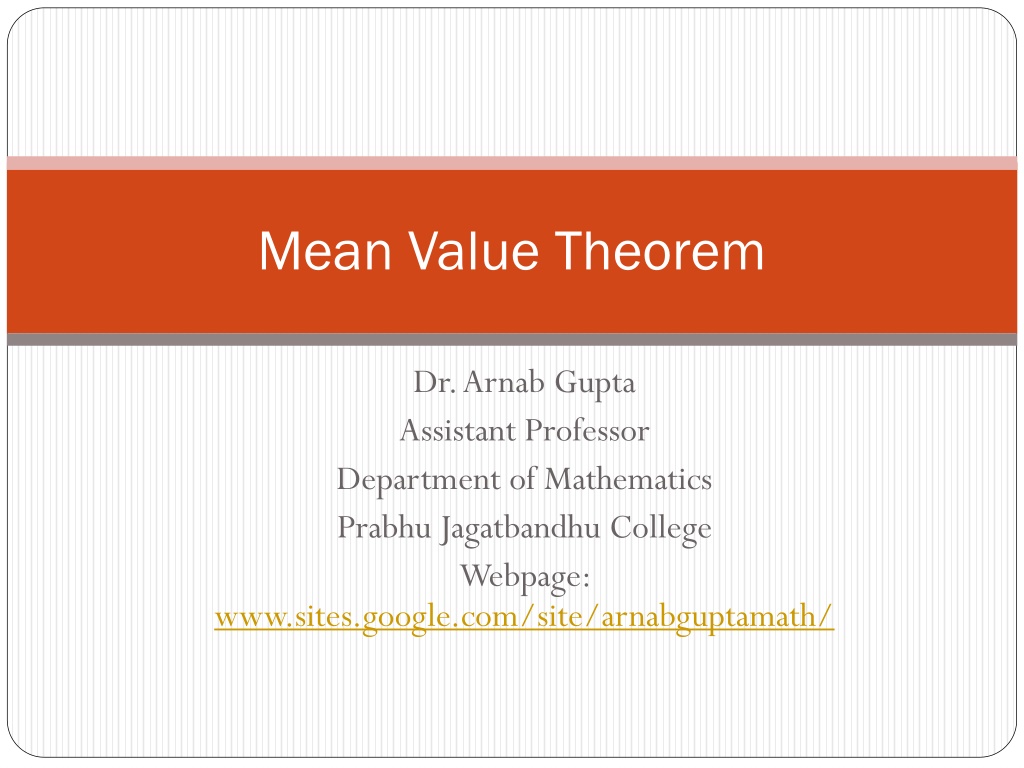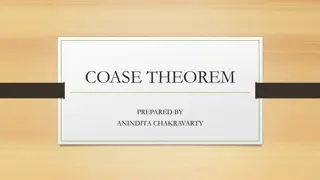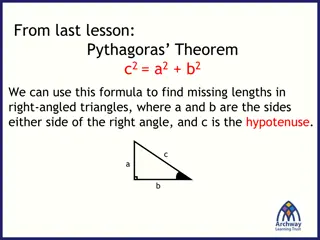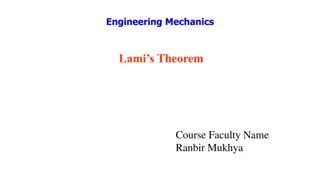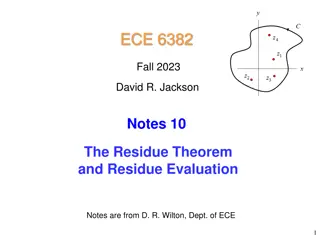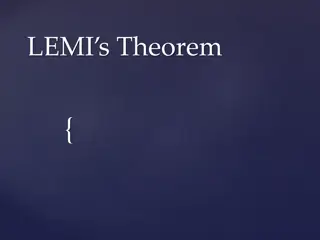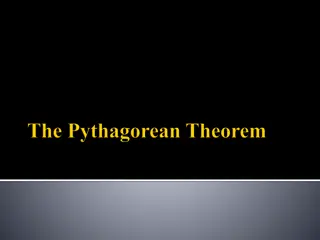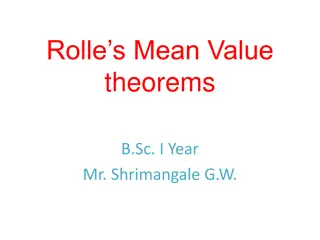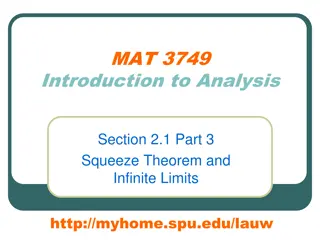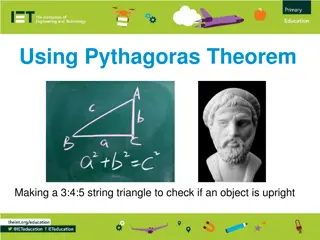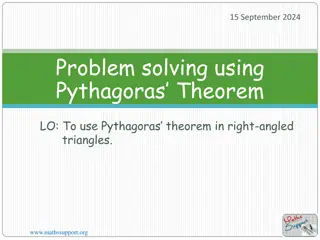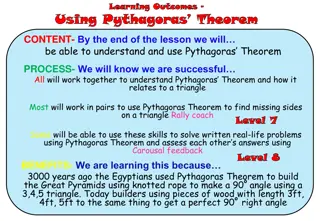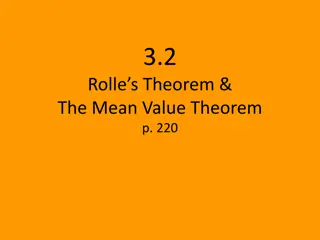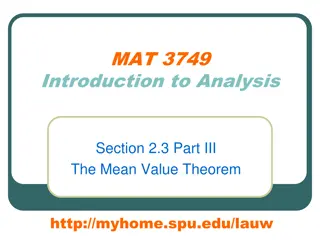Insights into the Mean Value Theorem and Its Applications
Delve into the Mean Value Theorem (MVT) with a focus on concepts like Lagrange's MVT, Rolle's Theorem, and the physical and geometrical interpretations. Explore the conditions, statements, and special cases of MVT, along with practical applications and geometric insights. Dr. Arnab Gupta, an Assistant Professor in the Department of Mathematics at Prabhu Jagatbandhu College, provides a comprehensive guide to understanding this fundamental theorem in calculus.
Download Presentation

Please find below an Image/Link to download the presentation.
The content on the website is provided AS IS for your information and personal use only. It may not be sold, licensed, or shared on other websites without obtaining consent from the author. Download presentation by click this link. If you encounter any issues during the download, it is possible that the publisher has removed the file from their server.
E N D
Presentation Transcript
Mean Value Theorem Dr. Arnab Gupta Assistant Professor Department of Mathematics Prabhu Jagatbandhu College Webpage: www.sites.google.com/site/arnabguptamath/
Curriculum Mean Value Theorem (MVT) Lagrange s MVT Rolle sTheorem Cauchy s MVT Applications
Motivation Law of Mean: For a smooth curve (a curve which can be drawn in a plane without lifting the pencil on a certain interval) y=f(x) (a x b) it looks evident that at some point c lies between a and b i.e. a<c<b, the slope of the tangent f (c) will be equal to the slope of the chord joining the end points of the curve. That is, for some c lies between a and b (a<c<b), f b f c f ( ) ( ) a = ( ) b a Physical Interpretation: The velocity of a particle (matter) is exactly equal to the average speed.
Mean value Theorem (Lagranges MVT) Statement: Let f(x) be any real valued function defined in a x b such that (i) f(x) is continuous in a x b (ii) f(x) is differentiable in a<x<b Then, there exists at least one c in a<c<b such that ( ) ( ) f b f a = ( ) f c b a Alternative form (by taking b=a+h, h: small increment) f(a+h)=f(a)+hf (a+ h) for some , 0< <1
Geometrical Interpretation of MVT For a continuous curve y=f(x) defined in a x b, the slope of the tangent f (c) (where c lies between a and b i.e. a<c<b) to the curve is parallel to the slope of the chord joining the end points of the curve.
Special Case of MVT Rolle sTheorem Statement: Let f(x) be any real valued function defined in a x b such that (i) f(x) is continuous in a x b (ii) f(x) is differentiable in a<x<b (iii) f(a)=f(b) Then, there exists at least one c in a<c<b such that f (c)=0. Note: All the conditions of Rolle s theorem are sufficient not necessary. Counter Example: i) f(x)=2+(x-1)2/3in 0 x 2 ii) f(x)=|x-1|+|x-2| on [-1,3]
Geometrical Interpretation of Rolles Theorem For a continuous curve y=f(x) defined in a x b, the slope of the tangent f (c) (where c lies between a and b i.e. a<c<b) to the curve joining the two end points a and b is parallel to the x-axis.
General case (Cauchys MVT) Statement: Let f(x) and g(x) be two real valued function defined in a x b such that (i) f(x) and g(x) are continuous in a x b (ii) f(x) and g(x) are both differentiable in a<x<b (iii) g (x) 0 for some a<x<b Then, there exists at least one c in a<c<b such that ( ) ( ) ( ) f b f a f c = ( ) ( ) ( ) g b g a g c
Alternative form: + + ( ) ( ) ( ) f a h f a f a h = ) 1 0 ( , + + ( ) ( ) ( ) g a h g a g a h
Interpretation (Cauchys MVT) Useful generalization of the law of mean by considering a smooth curve in parametric representation x=g(t) and y=f(t) (a t b). ( ) f c The slope of the tangent to the curve at t=c is ( ) g c The generalized law of mean asserts that there is always a value of c in a<c<b, for which the slope of the curve is equal to the slope of the tangent at c.
Observations Rolle sTheorem By taking f(x)=x in MVT MVT (Lagrange s) By taking g(x)=x in Cauchy s MVT Cauchy s MVT
Applications To estimate some values of trignometrical function say sin460 etc. Darboux s theorem: If the interval is an open subset of R and f:I R is differentiable at every point of I, then the range of an interval f is an interval (not necessarily an open set). [This has the flavour of an InternediateValue Theorem for f , but we are not assuming f to be continuous]. L Hospital s Rule: If f(x) 0, g(x) 0 and f (x)/g (x) L as x c, then f(x)/g(x) L as x c.
To deduce the necessary and sufficient condition of monotonic increasing or decreasing function. For a continuous function f:[a,b] R that is differentiable on (a,b), the following conditions are equivalent: (i) f is increasing (or decreasing) (ii) f (x) 0 (or f (x) 0 ) Not only the above examples but many more applications can found in different reference books from mathematics.
Books Recommended A first course in real analysis: Sterling K. Berberian. Springer. Mathematical analysis: Tom M. Apostol. Pearson Education Inc. An introduction to analysis: Differential calculus. Ghosh and Maity. New Central Book Agency. Methods of Real analysis. Richard R Goldberg. Wiley.
